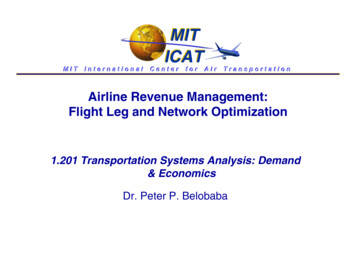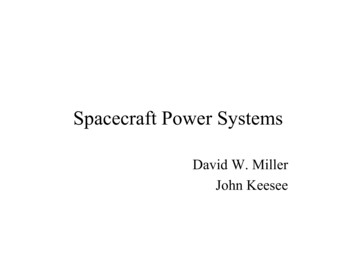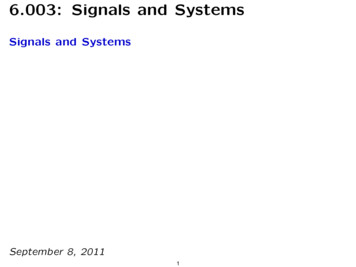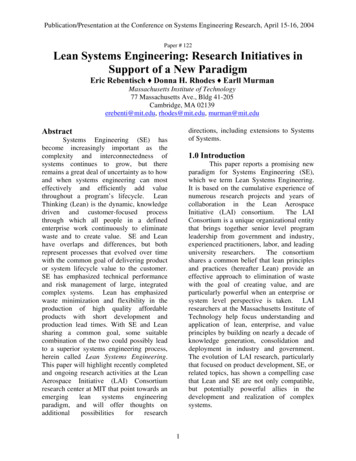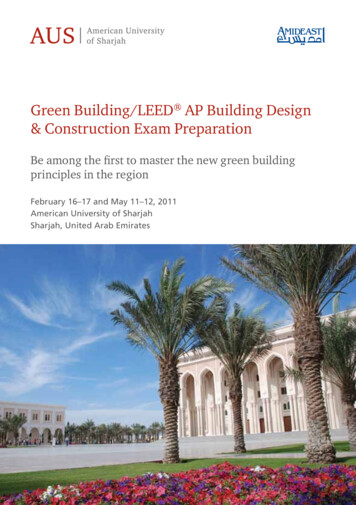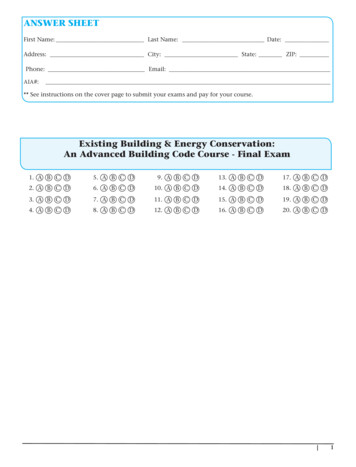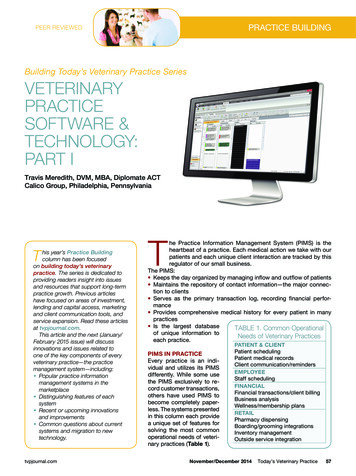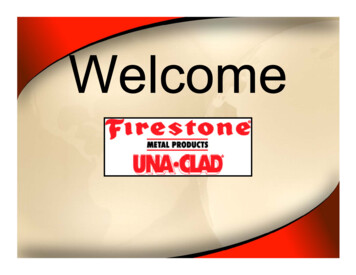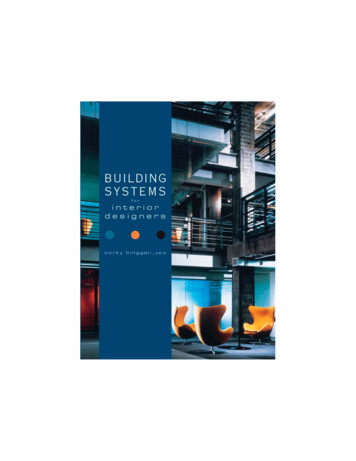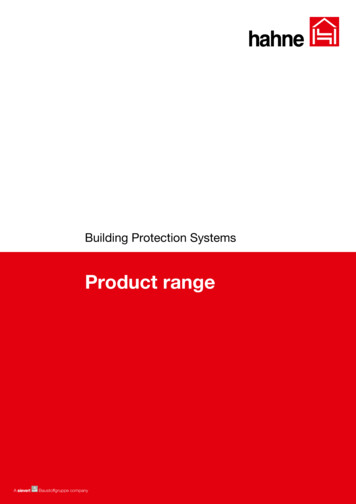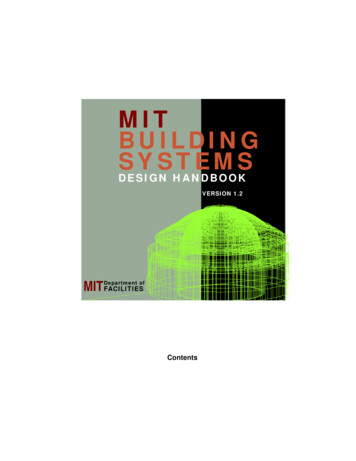
Transcription
MITBUILDINGSYSTEMSDESIGN HANDBOOKVERSION 1.2MIT FACILITIESDepartment ofContents
MIT Building Systems Design HandbookCopyright 2001 Massachusetts Institute of Technology. All rights reserved.This Building Systems Design Handbook was developed by MIT foruse exclusively by MIT’s Department of Facilities and its consultants fornew construction and renovation projects. This Handbook sets forthMIT’s preferred standards for its own building systems and is not intended to supercede any applicable regulations or codes nor is it intended to stand as a representation of industry standards. MIT makesno express or implied warranties with respect to the fitness for any particular purpose or accuracy of information provided in this Handbook.Users of the Handbook are required to fulfill their legal and professionalobligations and to meet all applicable municipal, state, and federal codesand regulations.Editions:Revised pages or sections are always identified by the version number located in the lower right corner of each page.Version 1.1 October 2001:The first published draft of MIT’s DesignHandbookVersion 1.2 December 2001: Revisions include only the information onthis new page and minor revisions to thePlumbing SectionBUILDING SYSTEMSDESIGN HANDBOOKver. 1.2
1234Massachusetts Institute of TechnologyDepartment of Facilities Building Systems Design Handbook567891011121314version 1.21516
IndexDIVISION 1 - General Requirements23Table of ContentUSERS GUIDEMIT SPECIAL REQUIREMENTSProject Management DocumentsGreenOperationsEHSInstitute SpacesLab ServicesGENERAL REQUIREMENTSSUMMARY OF WORKAPPLICATION FOR PAYMENTCOORDINATIONCUTTING & PATCHINGCODES, REGULATIONS, STADARDS & SUBMITTALSPROJECT MEETINGSCONTRACT MODIFICATION PROCEDURESSUBMITTALSDEFINITIONS & ACRONYMSMATERIALS & EQUIPMENTSCONTROL OF CONTAMINATIONHAZARD COMMUNICATION & CHEMICAL HANDLINGMOLDS, FUNGI, ANIMAL, BIRD AND BAT DROPPINGSCONSTRUCTION SITE SAFETY ISSUESSOIL & STORMWATER MANAGEMENT4567891011121314BUILDING SYSTEMSDESIGN HANDBOOKver. 1.11516
Summary of Key IssuesWhat is MIT’s Building Systems Design Handbook?The Design Handbook is a document available on CDROM thatdescribes MIT’s expectations for all of its construction projects aswell as the process for design review. (Formerly known as the“RED Book” or MIT Construction Guidelines)Who uses this document?MIT’s Project Managers, all design consultants, together with theMIT Stakeholders will use the Handbook as a working template forthe ongoing design and review process.Who are the MIT Stakeholders?They are the experts in the Engineering, Construction, Maintenance,and Operations Groups within MIT’s Department of Facilities. TheStakeholders are full participants in the writing and reviewing oftheir respective sections of this Building Systems Design Handbook.What is the role of MIT Stakeholders during the design process?At each milestone, consultants are required to submit to the ProjectManager a completed and signed Design Review Checklist whichforms the basis for a formal Design Review Meeting with the stakeholder groups. In addition, a list of Required Engineering Documents appears in the General Requirements section of the Handbook.Who has the pivotal role in the design & review process?MIT’s Project Managers are responsible for balancing program &budget with the requirements of the Design Handbook. The ProjectManager will negotiate with the Stakeholders to solve any conflictsand, if needed, can request a review with the Directors.How will this document be updated ?MIT will notify all active designers as periodic updates of the Handbook become available for distribution on CDROM. Each individualpage of the Handbook will include the Version label in the lowerright corner so that users can identify immediately which portionshave been revised.BUILDING SYSTEMSDBUILDINGE S I G N H A SYSTEMSNDBOOKver. 1.1
Mission Statement:The MIT Department of Facilities provides the physical environment, utilities, and support services necessaryto promote the educational and research activities of the Institute. This is accomplished by the Engineering,Construction, Maintenance, and Operating Groups of Facilities. To ensure quality service to the MIT community, the department provides strong coordination and communications between multi-functional groups andour customers. Training and the development of self-directed work teams promotes a work environment thatencourages employee initiative and development. We strive to be a customer services oriented department.To communicate its needs to designers, the Department of Facilities employs two key mechanisms: anestablished process for Design Review and a set of Construction Guidelines. The latest version of the DesignGuidelines is this electronic DESIGN HANDBOOK---a name that reinforces its importance to designers as thestatement of MIT’s goals for its construction projects and, in addition, distinguishes this document from itspredecessor known as the “RED Book” (MIT Construction Guidelines). The State Building Code is the starting point for MIT’s target zone for system performance. The HANDBOOK guides users towards standards ofconstruction appropriate for the many different types of projects at the Institute. Finally, by requiring designers to submit signed Design Review Checklists at each project milestone, the HANDBOOK promotes anongoing dialogue between design consultants and the experienced Engineering, Construction, Maintenance,and Operating Groups within the Department of Facilities who are referred to in this HANDBOOK as MITStakeholders.2 MITAmount ofConstruction1 0-1Non-existingor in disrepairExistingCodes"Grandfathered"CodesCodeof Design3 100%ComplianceInsuranceUnderwriter4 High RiskEnvironments(e.g. NuclearPower Plant)DeficientRELIABILITYVersion 1.1 of the new DESIGN HANDBOOK is issued to all MIT Stakeholders, MIT Project Managers and todesign consultant teams as a goal to be met by all projects. All consultant teams will be notified of eachrelease; however, each new issue will be an advisory document for designers that are already contractuallybound to prior versions of the CODE. Projects currently in the construction documents phase or in construction will not be required to adhere to a new version where cost or major redesign would be necessitated.Designers will be notified by MIT’s Project Managers if implementation of any new CODE requirements willbe mandated for their projects.(next page)(return to Key Issues Summary)BUILDINGSYSTEMSSYSTEMSBUILDINGDESIGN HANDBOOKver. 1.1
The DESIGN HANDBOOK describes MIT’s goals for building systems as well as certain special requirementsfor all construction projects. MIT’s Project Managers, design consultants and MIT Stakeholders will use thisHANDBOOK as a working template for the ongoing building system design and review process throughoutthe design and construction project. The Institute’s goal is adherence to HANDBOOK provisions as well as tobudget and schedule. The new HANDBOOK is available on compact disc in a cross-platform PDF format.Further information about HANDBOOK use and future updates as well as procedures for systematic designreview are found below.Click on the blue highlighted links. To return to beginning of any section, click on the vertical heading in upperright page margin1 Users GuideBuilding Systems Design Review MatrixStakeholders Groups & Design ReviewOverviewNavigationUpdatesAcknowledgements1 MIT Special RequirementsMIT Department of Facilities Project Management Documents :Required Engineering DocumentationEnvironmental Guidelines for Project ManagersPre-pricing Design Review Submittal Requirements for Space ChangesGreen DesignOperationsEHSLab ServicesInstitute Spaces(back)BUILDING SYSTEMSDESIGN HANDBOOKver. 1.1
MITDEPARTMENT OF FACILITIESUSERGUIDEBuilding Systems Review Matrix:Building SystemRequirements:SITE &LANDSCAPELandscape DesignSite Utilities(See Utilities)ParkingExterior LightingIrrigationMIT SpecialRequirements:(overlays)Stakeholder GroupSHELL ICALSYSTEMSBuilding EnvelopeFurnitureDomestic WaterWaste Water Drainage Supply & Make-up AirInterior FinishSignage & GraphicsFire ProtectionFresh Water SupplyExhaust SystemsBuilt-insRoom NumberingStorm WaterHeating & CoolingEquipmentSanitary SewerLock Sets & KeyingDuct Banks / TelecomSmoke/Water MitigationSteam & CondensateHousekeepingHot WaterADAChilled WaterStakeholder GroupCONTROLStakeholder GroupStakeholder GroupStakeholder GroupStakeholder GroupFIREPROTECTIONINFORMATIONSYSTEMSFCSOther SystemsHigh VoltageLow voltageFire AlarmVertical TransportationMeteringFire Alarm SystemsSprinkler SystemsSpace RequirementsTransmissionServicesStakeholder GroupStakeholder GroupStakeholder GroupStakeholder GroupPROJECT MANAGEMENTAPPROACHStakeholderGroupDEPARTMENT OF FACILITIES DIRECTORS: CAPITAL PROJECTS / SPACE CHANGES / SPECIAL PROJECTSPLANNING / PROGRAM /DESIGNStakeholderGroupMIT PROJECT PLANNER:BUDGET / SCHEDULE /CONSTRUCTIONStakeholderGroupMIT PROJECT MANAGER:CAMPUS FRAMEWORKSStakeholderGroupHISTORIC PRESERVATION / BULDING LINKAGE / LOBBIES & STAIRWAYS / CORRIDORS / SECURITY / ART / SIGNAGE / SPECIAL EVENTSLABORATORY SERVICESStakeholderGroupLABORATORY WASTE / VACUUM / PROCESS CHILLED WATER /GASES / COMPRESSED AIR/ PIPING / SPACE G / REPAIR AND MAINTENANCE / OPERATIONS / WARRANTEES / RENEWALENVIRONMENT HEALTHSAFETYStakeholderGroupHAZARDOUS MAT'LS / WASTE WATER / SOLVENT STORAGE / AIR QUALITY / SUPPLY & EXHAUST AIR / FUME HOODS / RISK MANAGEM'T / MAT'LS HANDLINGGREEN DESIGNStakeholderGroupSUSTAINABLE SITES / WATER EFFICIENCY / ENERGY CONSERVATION / MATERIALS / INDOOR QUALITY / RISK MANAGEMENTSPECIAL OCCUPANCYREQUIREMENTSStakeholderGroupDORMITORIES / LABORATORIES / CLASSROOMS / OFFICES / FOOD SERVICE / ANIMAL FACILITIES / LIST VISUAL ART CENTER / MIT MUSEUMMIT PROJECT MANAGEMENT MANUALMIT PROJECT MANAGEMENT MANUALback to textBUILDING SYSTEMSDESIGN HANDBOOKver 1.1
Stakeholder Groups and Design ReviewThe Handbook is organized into 16 divisions loosely based on the CSI format. Sections within the divisionscorrespond to the MIT Stakeholder groups which consist of individuals within the Department of Facilitieswho, based on their particular experience and responsibilities at MIT, have contributed to the infomationcontained in that division. Each stakeholder assisted in the writing of the sections within the divisions. Thesesame Stakeholders are the principal participants in the ongoing Design Review process that takes placeduring the design phases of a construction project. See BUILDING SYSTEMS REVIEW MATRIX.MIT Project Managers and the Design Review Process:The process of Design Review is built around the traditional milestones of the design process. The processmay be streamlined at the discretion of MIT’s Project Manager as a response to the size of the project;however, no project at MIT should be exempt from the process. At each design milestone (typically Schematic Design, Design Development, and Construction Drawings) the designer will be required to submit tothe MIT Project Manager a completed Design Review Checklist* found in each of the sections of theHandbook . This checklist, which must be signed and dated by the consultant, will highlight areas inwhich full compliance has been accomplished as well as areas where the designer may be requesting variances.Project Managers will review the completed checklist and based on its thoroughness will schedule the formalDesign Review Meeting with the stakeholder groups.The MIT Project Manager has the pivotal role in the design process as the person responsible for balancinga project’s program, budget, schedule and Handbook compliance. Since the right balance among theseproject factors is often difficult to maintain, the Project Manager must work closely with the Stakeholders andwith the Directors of the Department of Facilities:oThe Project Manager will work closely with the Stakeholders group to seeksatisfactory solutions when conflicts arise between strict Handbookcompliance and the established project budget or schedule.oIf Handbook/budget/schedule conflicts remain unresolved, the Project Manager candecide to request a review by the group of Directors.The Design Handbook and its checklists augment the extensive procedural information already provided to the Institute’s Project Managers in the Department of Facilities Project Management Manual.Value Engineering and Changes during ConstructionChanges from the approved design during construction or after bids are received can undermine the DesignReview process and the intent of the Handbook itself. After Construction Drawings are completed,ongoing reviews and changes to the project could be in conflict with prior agreements and understanding of theStakeholder Groups. For this reason any deviations from the Handbook due to value engineering or constructionchanges must go through the Project Manager in accordance with the Design Review process.* See also Required Engineering Documentation, a list of specific information including calculationsrequired by the MIT Engineering Stakeholders group for every project.BUILDING SYSTEMSDESIGN HANDBOOKver. 1.1
OverviewThe new DESIGN HANDBOOK is created in PDF format in cross-platform software developed by Adobe.This PDF format is easy to open and read with any operating system and computer profile. Althoughnavigation through the document is not difficult, there is basic help available in the PDF reader found in theupper right hand corner of the tool bar (Reader Online Guide).A few basic elements of the CODE with which users should familiarize themselves: The CODE is organized loosely on a CSI format with divergences to better mesh with how MIT’s Department of Facilities is organized. Each Division can be accessed through the main index page or throughthe Division Index pages. Links to related items are highlighted throughout the C
The Handbook is organized into 16 divisions loosely based on the CSI format. Sections within the divisions correspond to the MIT Stakeholder groups which consist of individuals within the Department of Facilities who, based on their particular experience and responsibilities at MIT, have contributed to the infomation contained in that division .
